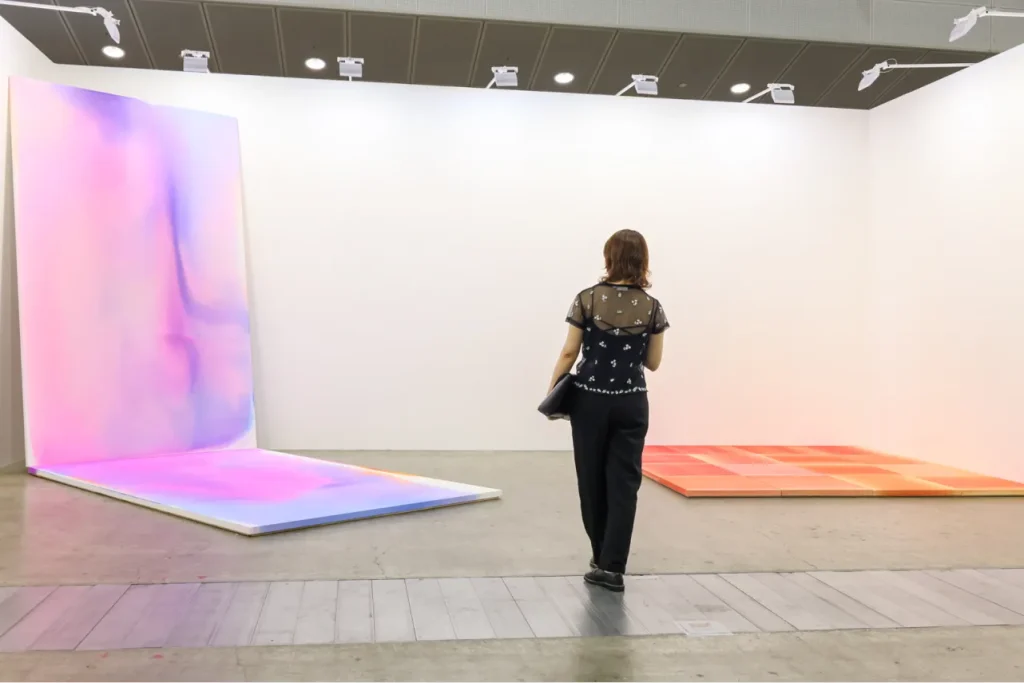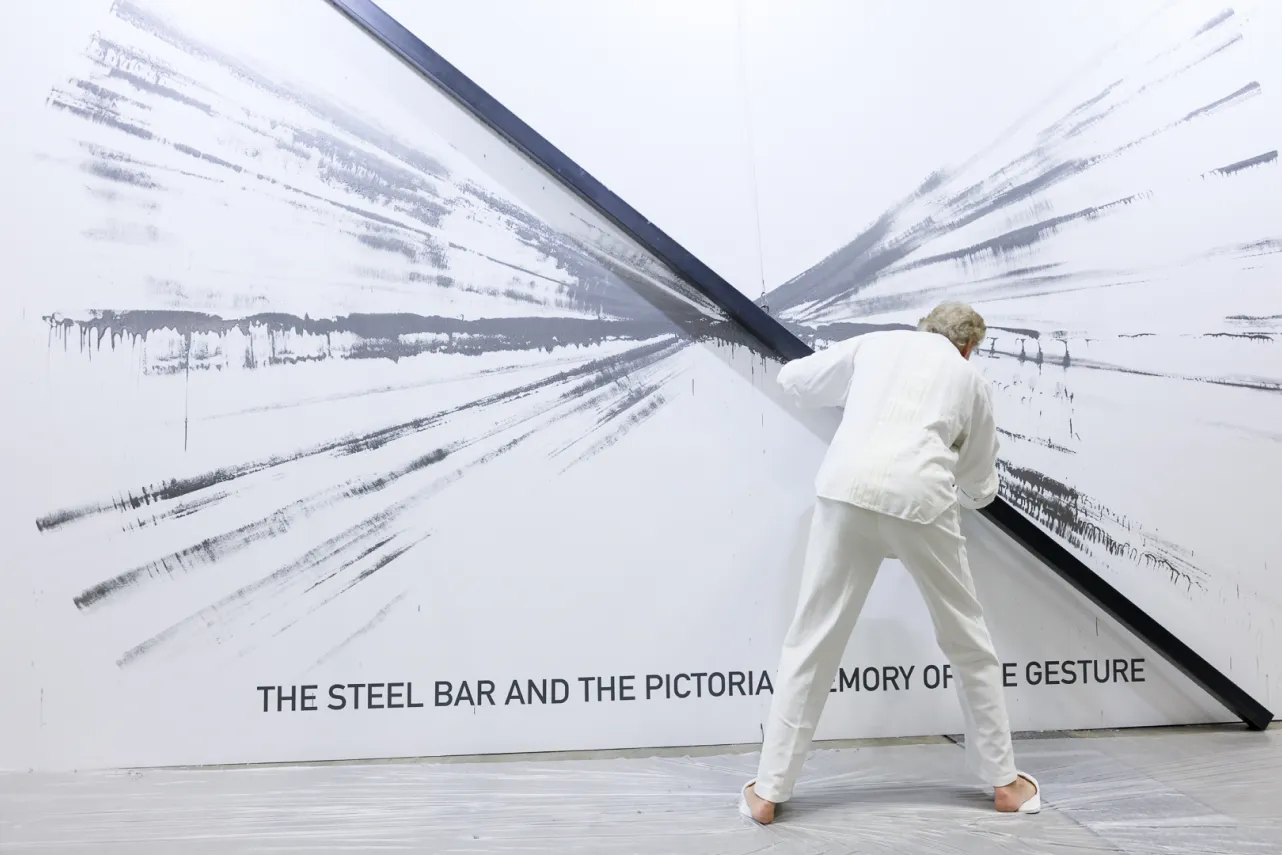
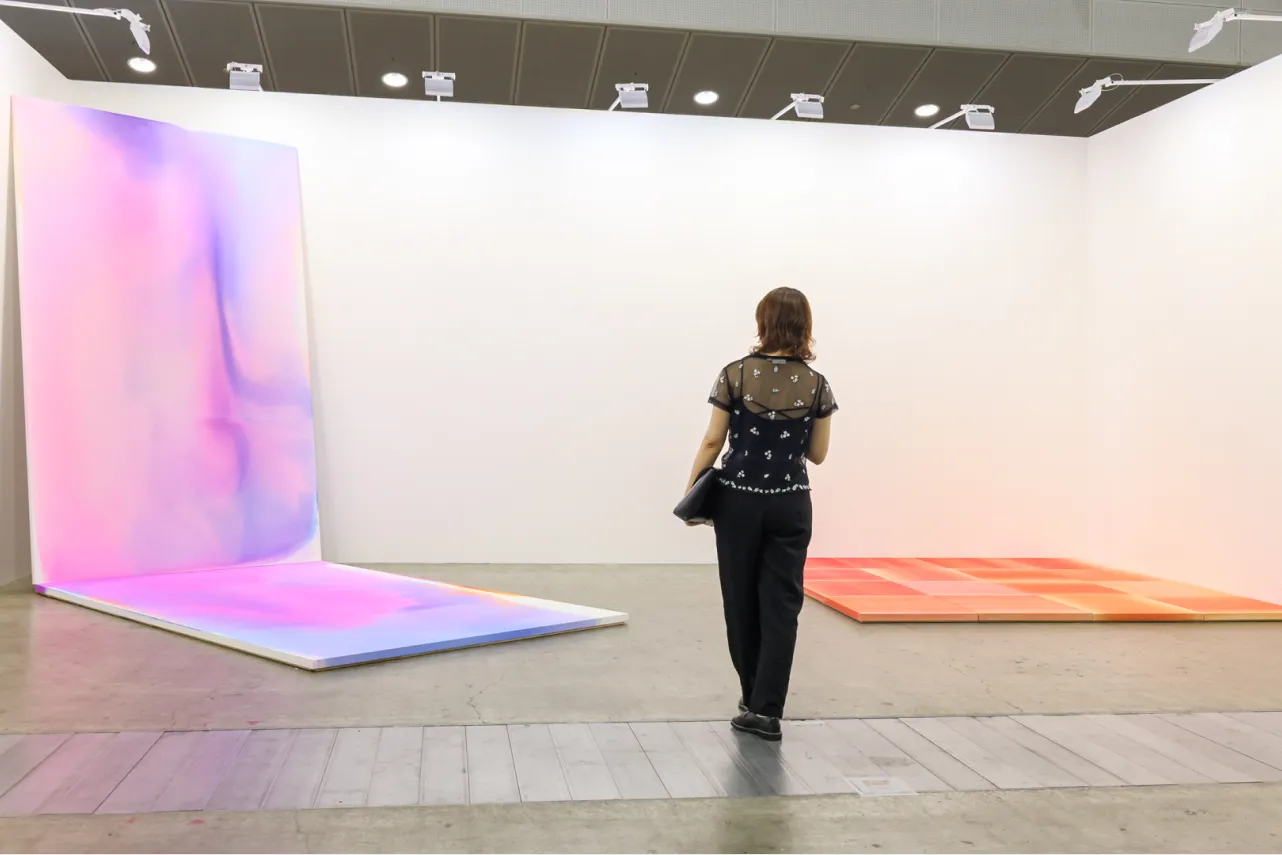
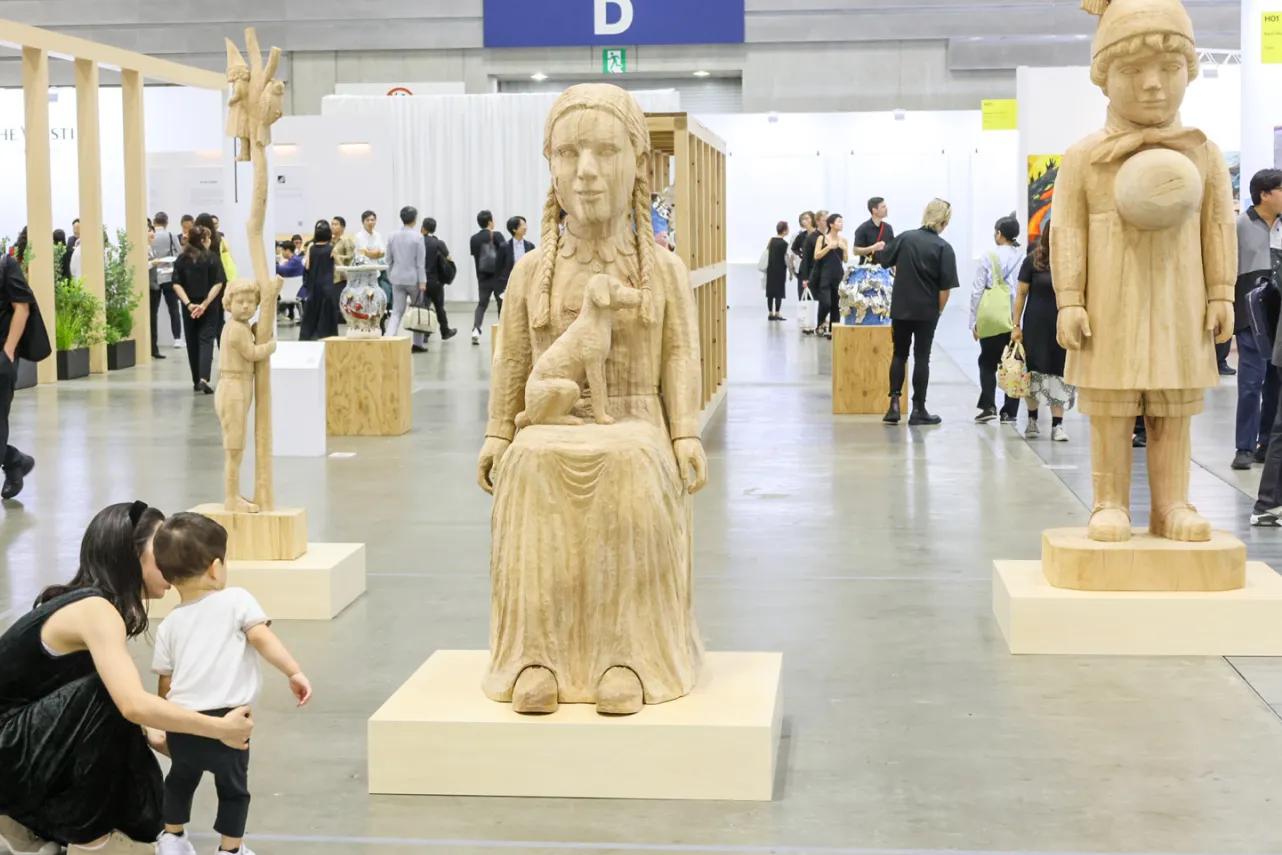
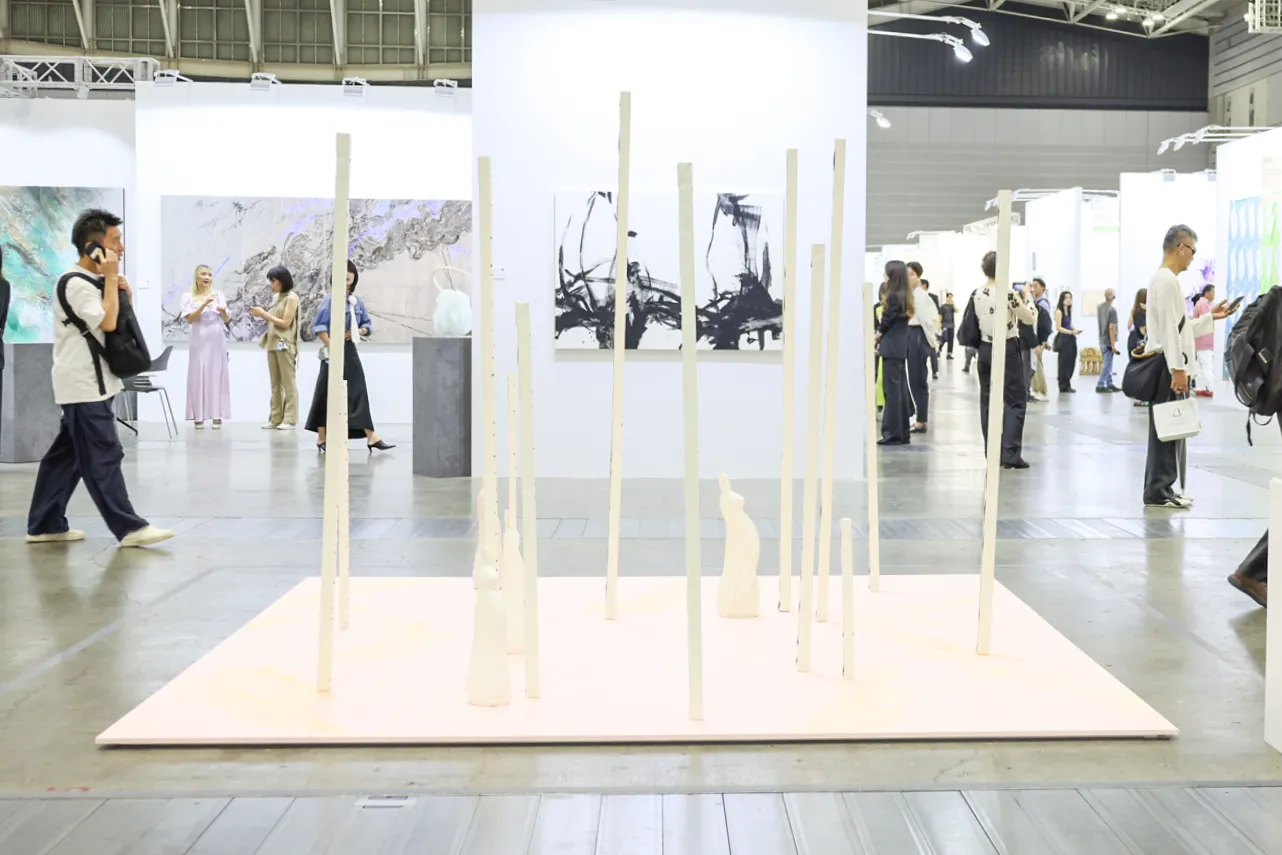
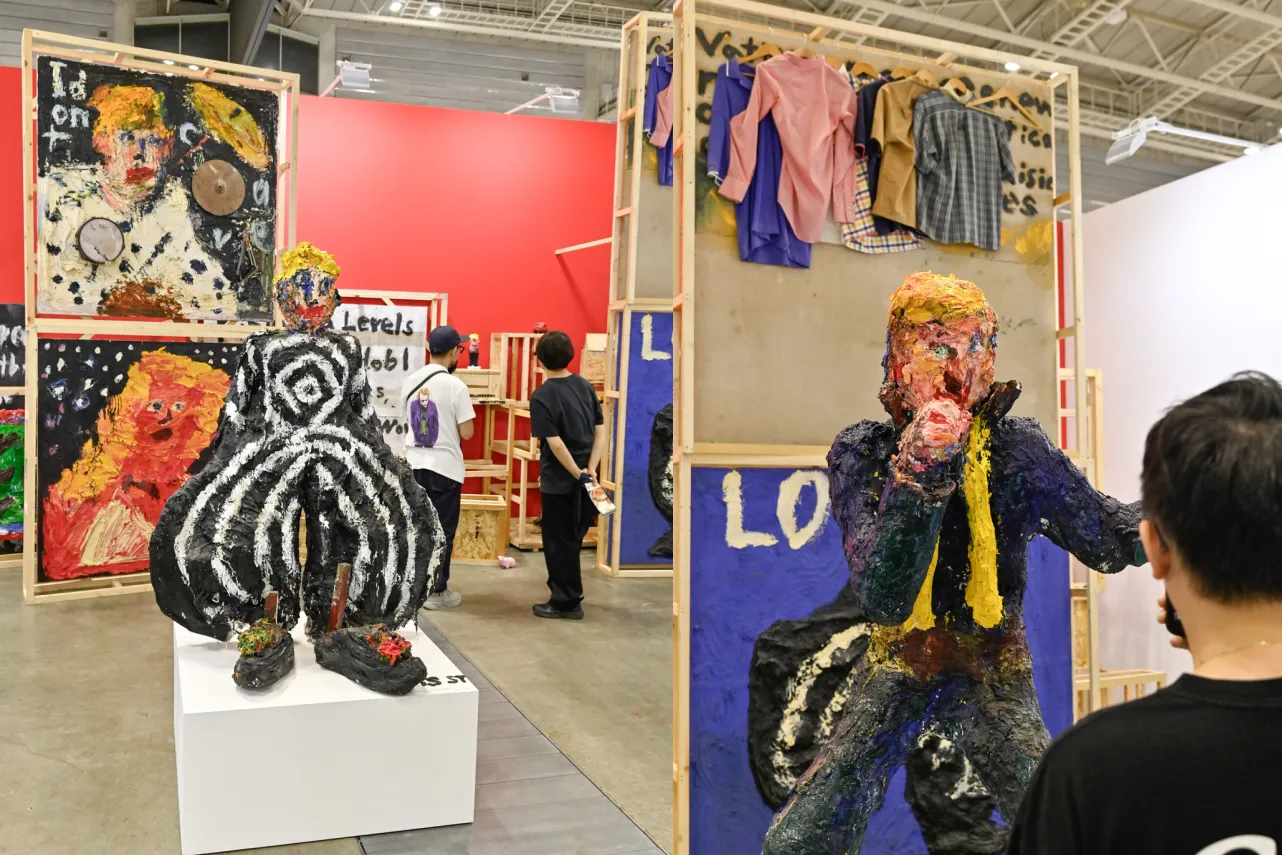
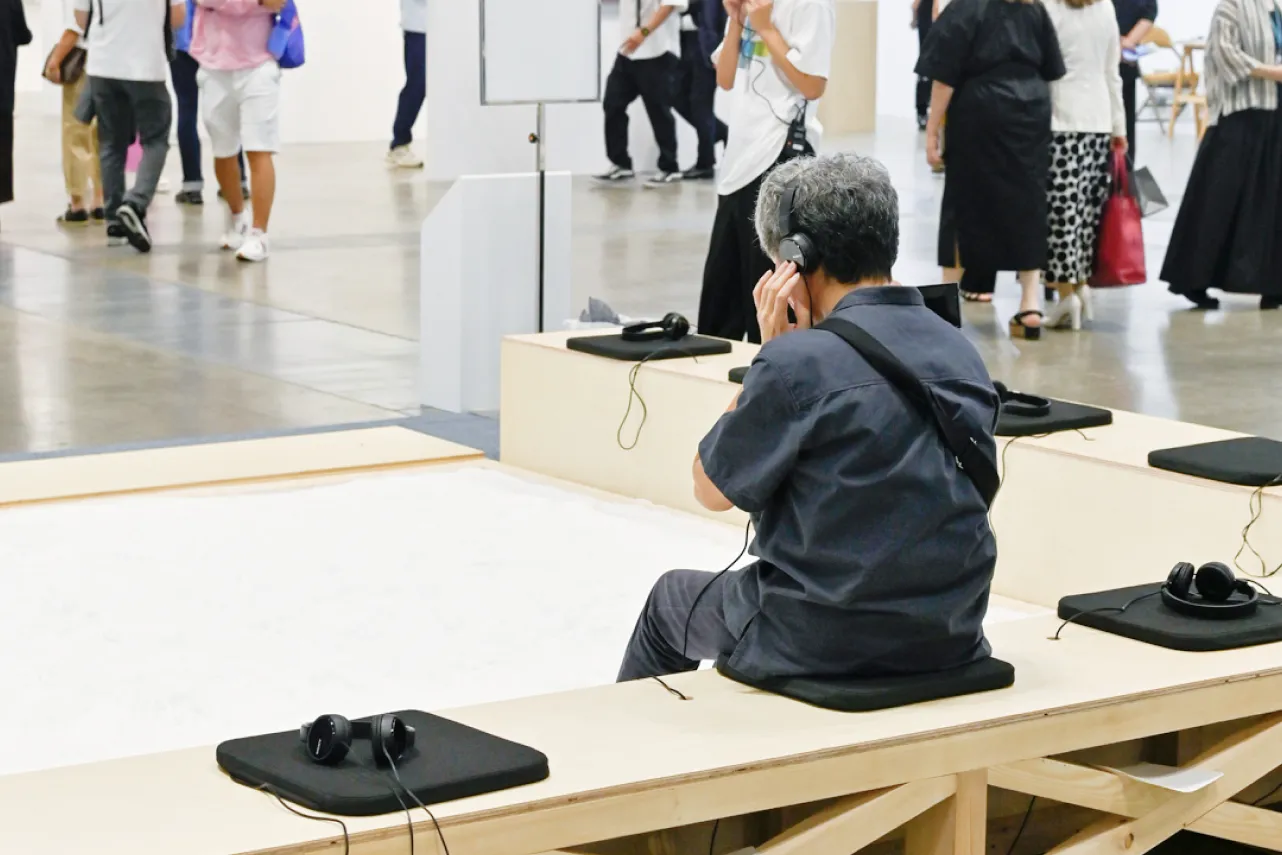
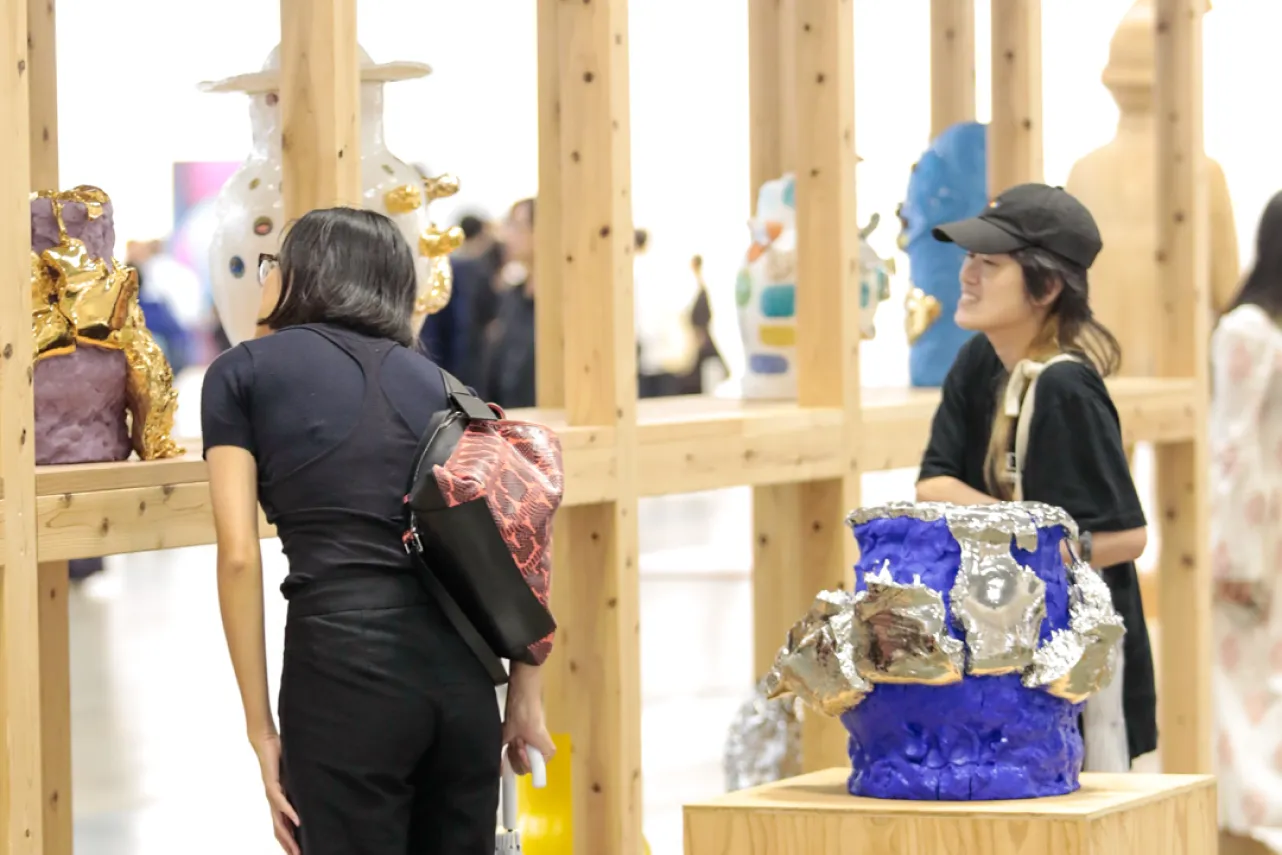
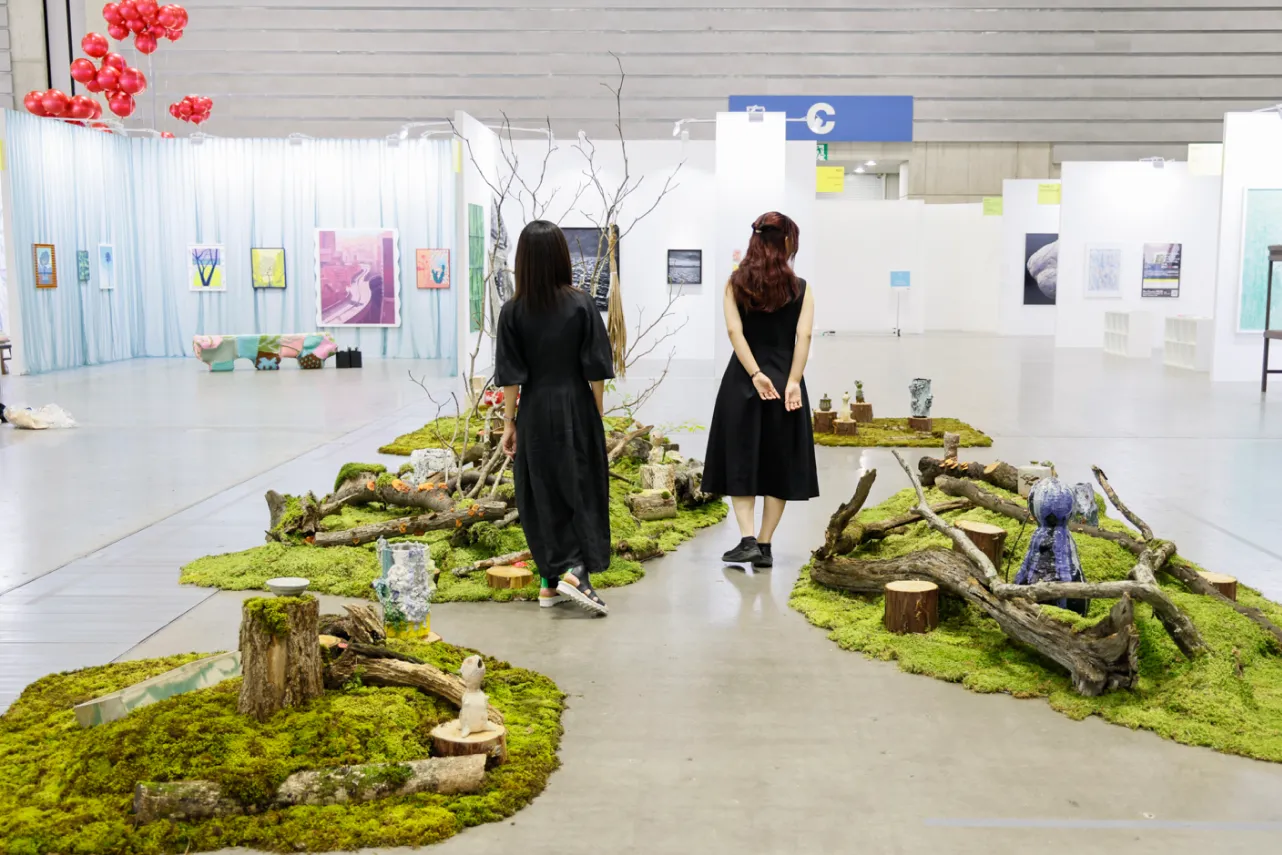
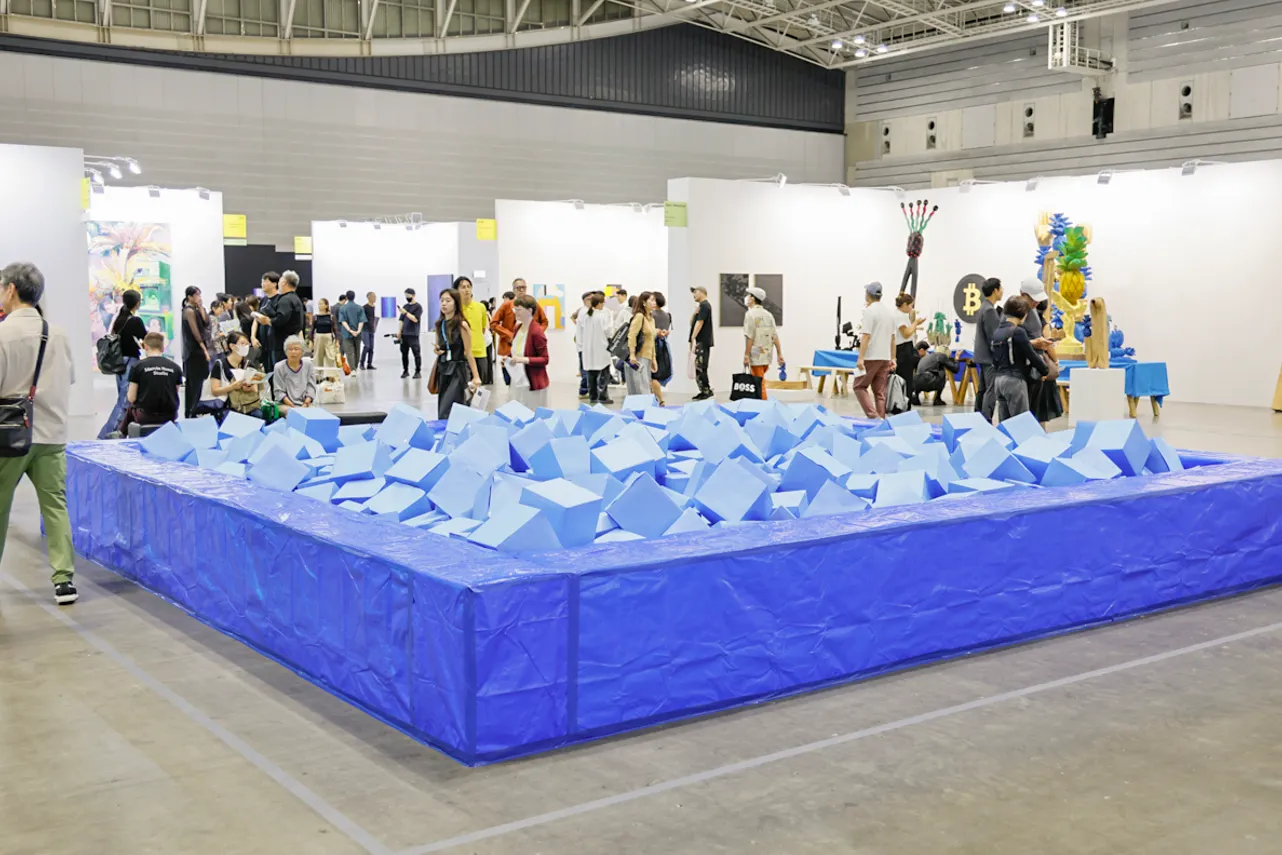
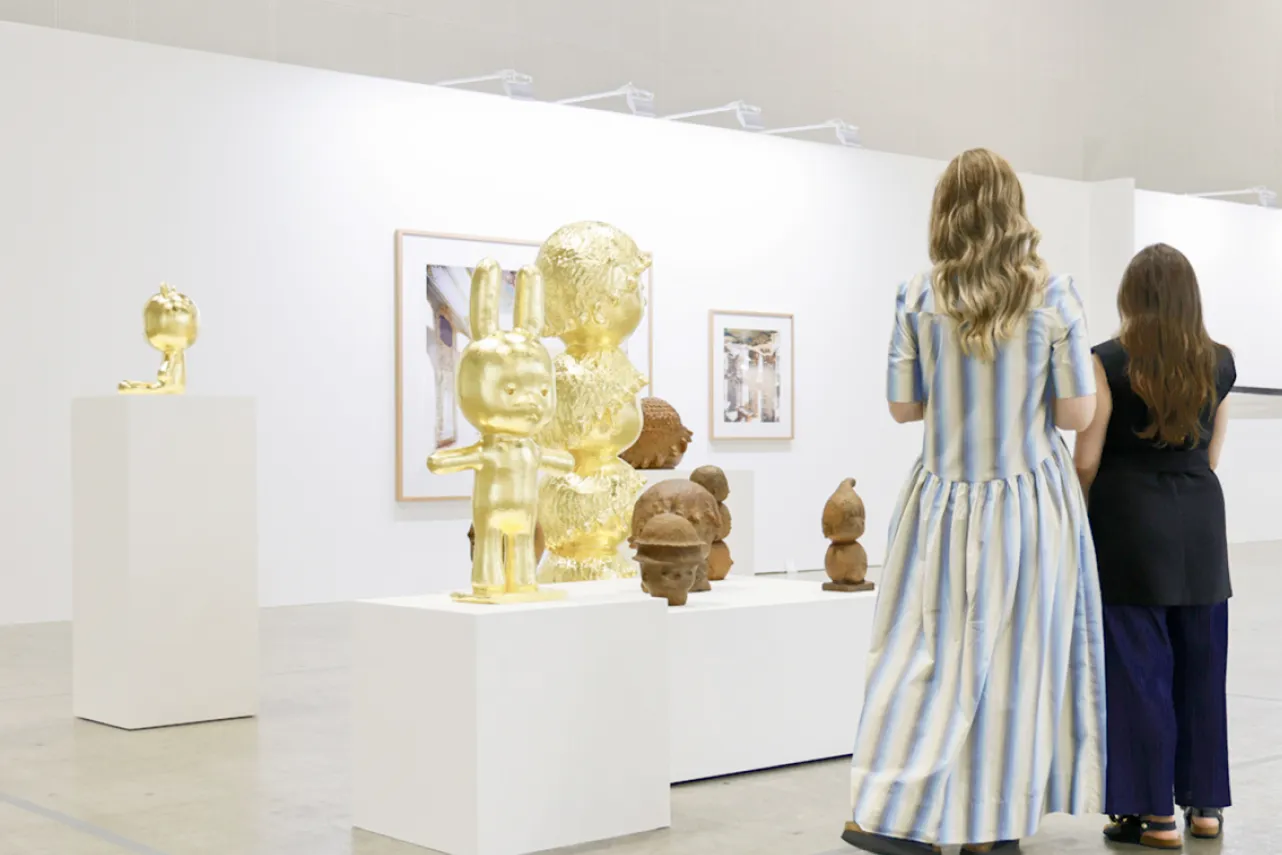
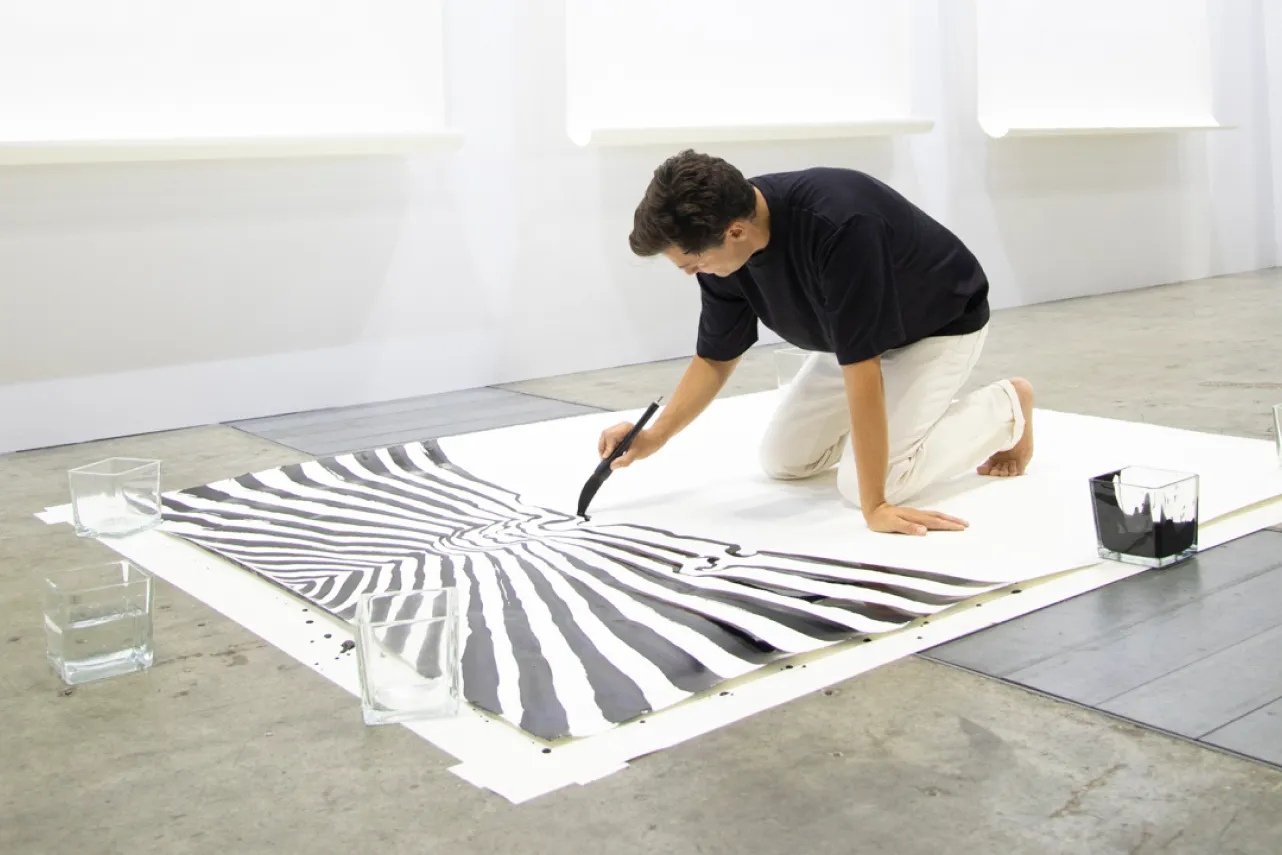
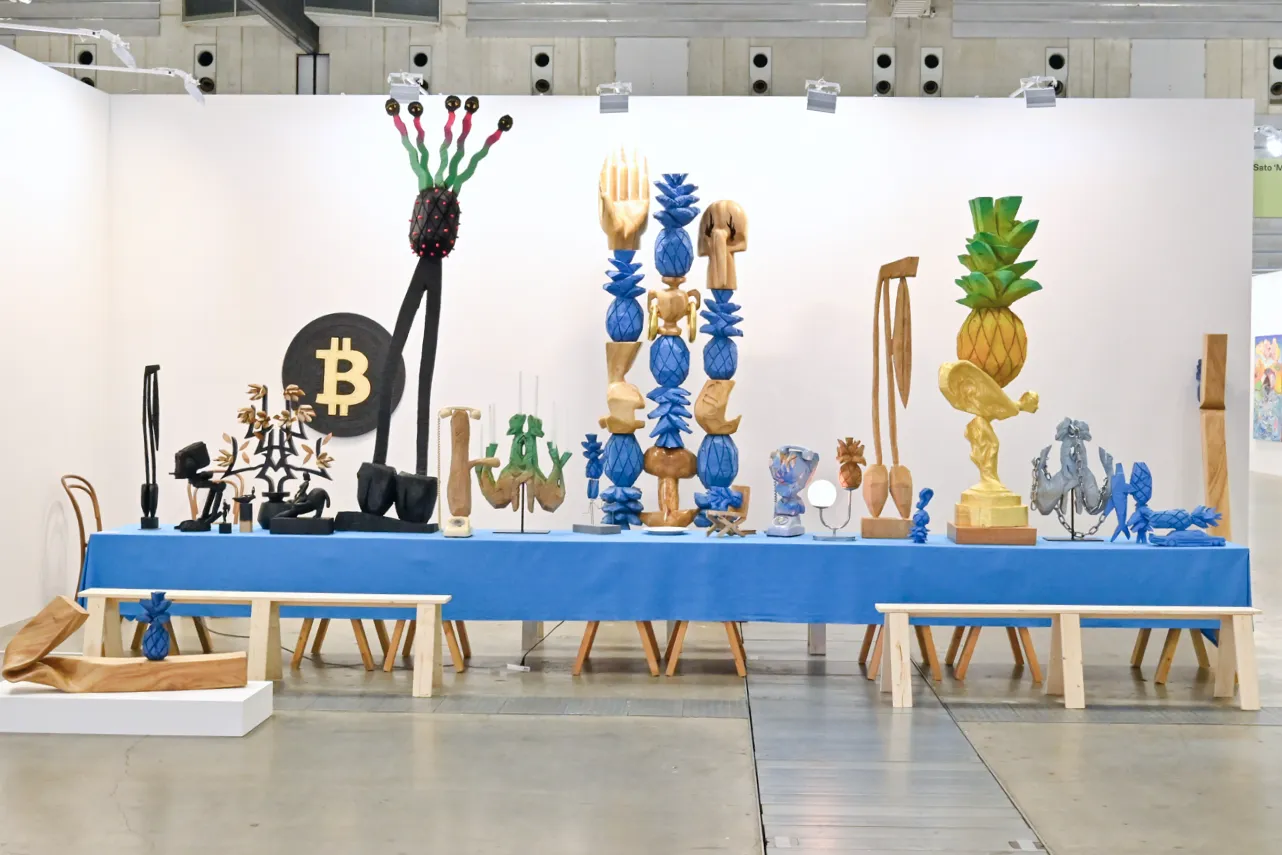
Sato 'Meadow' in 2025
12 installations were on view at the 2025 edition of Tokyo Gendai. Tap the thumbnails below for more information on each piece.
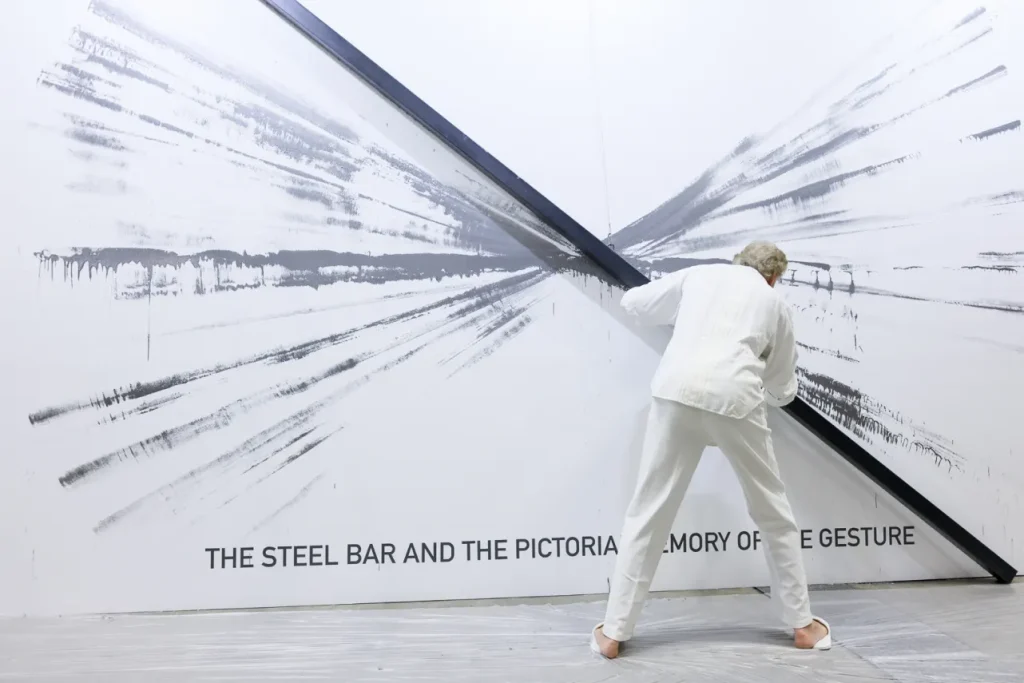
Bernar Venet − Ceysson & Bénétière
The Steel Bar and the Pictorial Memory of the Gesture
The Steel Bar and the Pictorial Memory of the Gesture continues the artist’s exploration of the dynamics between line and material, form and force, the rational and the organic. As part of Tokyo Gendai’s Sato sector, a performance was held in which Venet created a site-specific work that captured these elements directly on the walls of the fair. The artist’s unique process involves the use of a metal bar covered in paint; the resulting visual image is determined by the artist’s gesture and movement, the angle of the bar, the nature of the material, and the fluidity of the paint.
Bernar Venet performed on-site at Tokyo Gendai in booth #S01 on 11 September from 5:30 PM to 5:45 PM.
Acrylic paint on canvas, accompanied by steel bar and cable, 2025
Dimensions: site-specific
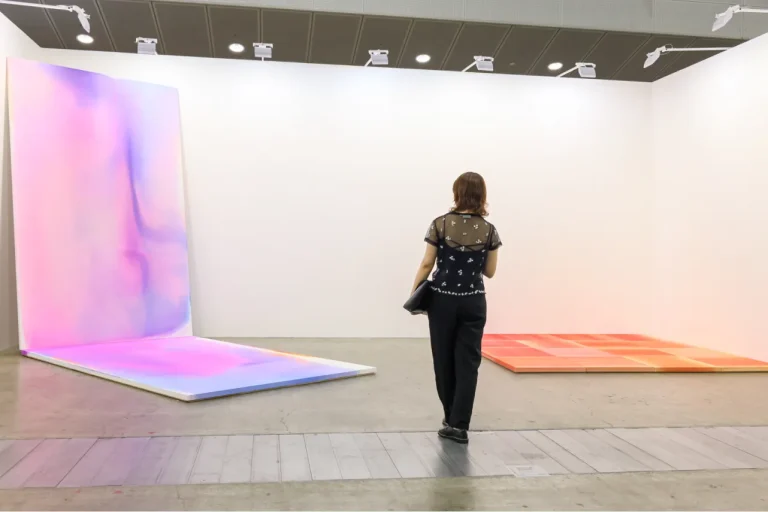
Kim Taek Sang − Johyun Gallery
Ephemeral
Johyun Gallery presented Kim Taek Sang’s new installation of large-scale works in the Sato space, continuing his meditative exploration of pigment, water, and light through his unique ‘dàamhwa’ (淡畵) painting process.
Kim Taek Sang has been experimenting with the diffusion, sedimentation, and layering of color for over three decades through the medium of water. His process is iterative—mixing trace amounts of pigment into water, pouring the solution onto a canvas laid flat, then allowing it to dry. Repeated dozens of times, this practice is both ascetic and curative; he has come to describe it as the aesthetics of care. This delicate layering of sediment on canvas creates subtle interstices that scatter light and permeate the surface with depth and density, evoking nature’s own palette of serene and understated hues. Kim describes his creations as dàamhwa, where dàam carries meanings of clear, delicate, faint, or thin in tint.
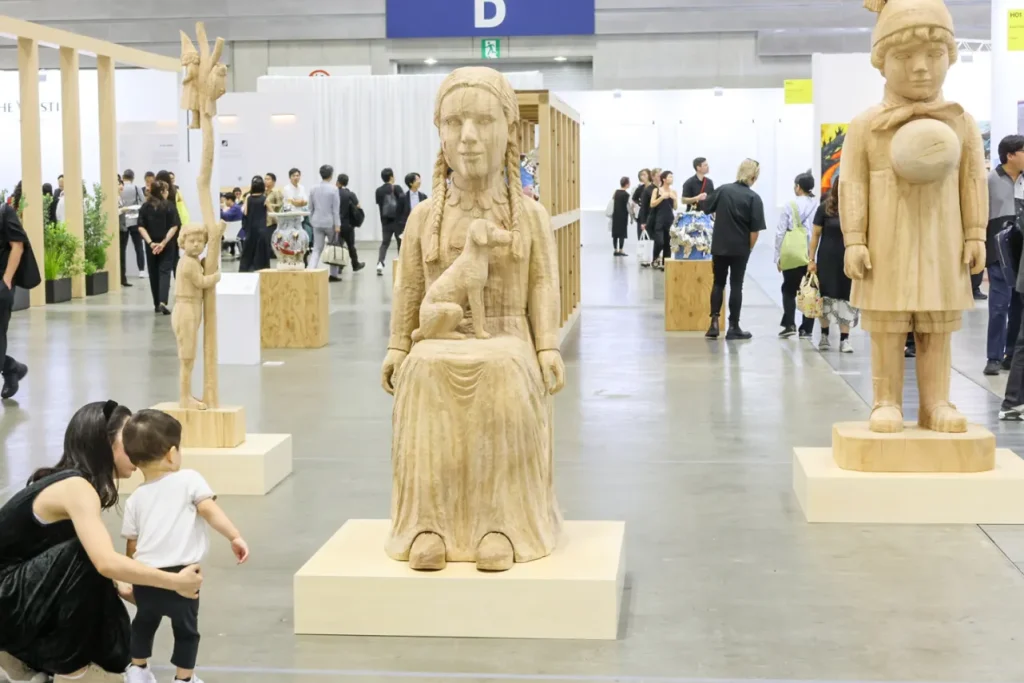
Rieko Otake − Tomio Koyama Gallery
Tree, Tears, Her
Rieko Otake’s wooden sculptures, often depicting motifs such as girls, birds, and children, carry a tactile warmth that evokes nostalgia and familiarity. The roughly carved wood is left unpainted, exposing its raw texture as if to preserve a connection to the living nature of the material itself. Within these works resides a delicate sense of presence. Otake’s sculptures gently touch upon the viewer’s own childhood memories, while simultaneously leading them into a mysterious, dreamlike otherworld.
The works featured in this presentation were exhibited in “Rieko Otake: Me, Here” the 31st Hirakushi Denchu Award Commemorative Exhibition held from April to June 2025.
“Tears” (2024) portrays an enormous child-like figure with a quiet, tearful expression. From its chest protrudes a large form resembling a strange growth.
“Her” (2025) features a towering girl with a dog resting on her knees. Without touching the animal, she offers the faintest smile, her eyes gazing intently into the distance.
Both sculptures, standing around two meters tall, possess a gentle but commanding presence — their tranquil, poetic aura softly evokes the viewer’s imagination.
Tomio Koyama Gallery artist page for Rieko Otake:
https://tomiokoyamagallery.com/en/artists/rieko-otake/
For enquiries, please contact [email protected] .
Tree, wood (Camphor Tree), 212 x 44 x 33, 2022
Tears, wood (Camphor Tree), 220 x 68.3 x 70.5, 2024
Her, wood (Camphor Tree), 175 x 70 x 80, 2025
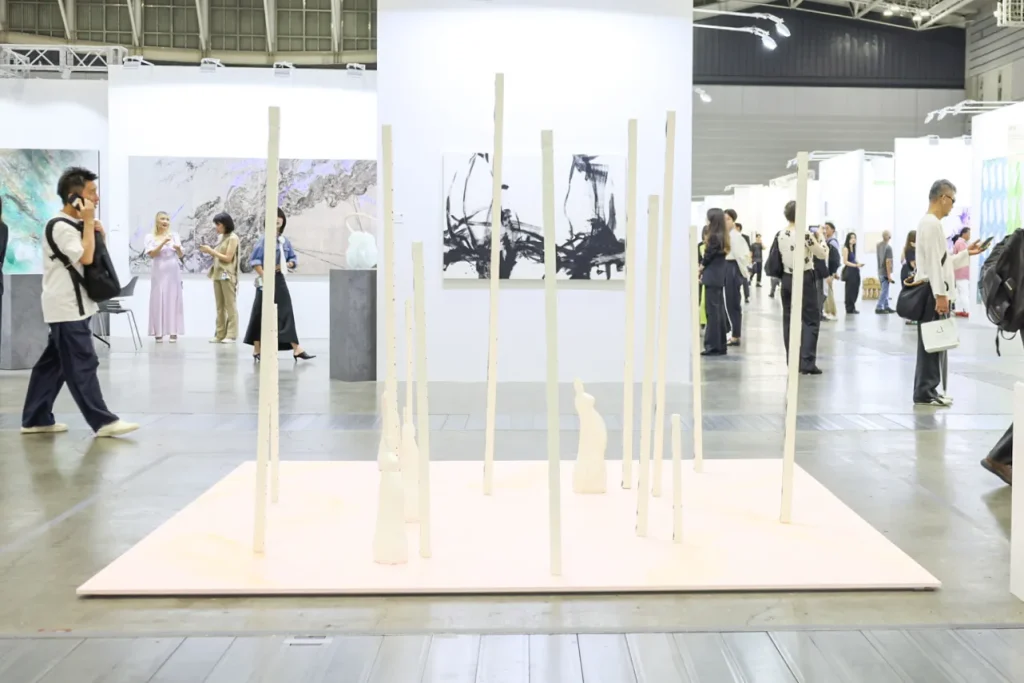
Yuko Murata − GALLERY SIDE 2
birch garden
Yuko Murata’s installation at Tokyo Gendai combines her tall paintings that are made to look like birch trees and her ceramic rabbits. The viewer is invited to walk among Murata’s “birch garden”. Yuko Murata, a Japanese painter, is known fro her small paintings with vibrant brush strokes. Since 2010, She has been experimenting with ceramic works that occupies the space. First apprenticing at Mashiko master, then entering a ceramic school. In 2025 he has completed ceramic rabbits with surfaces that remind one of Japanese traditional sweets. When she showed at Shiseido’s The Ginza Space in 2021, she has created tall and thin paintings that stands in the space. Long square timbers are wrapped with canvas and then painted. At Tokyo Gendai, Murata combines the 2 elements and makes her “birch garden”. The viewer is invited to stroll among the works.
Oil on canvas on wood, ceramic, 300 x 370 x 300 cm, 2021-2025
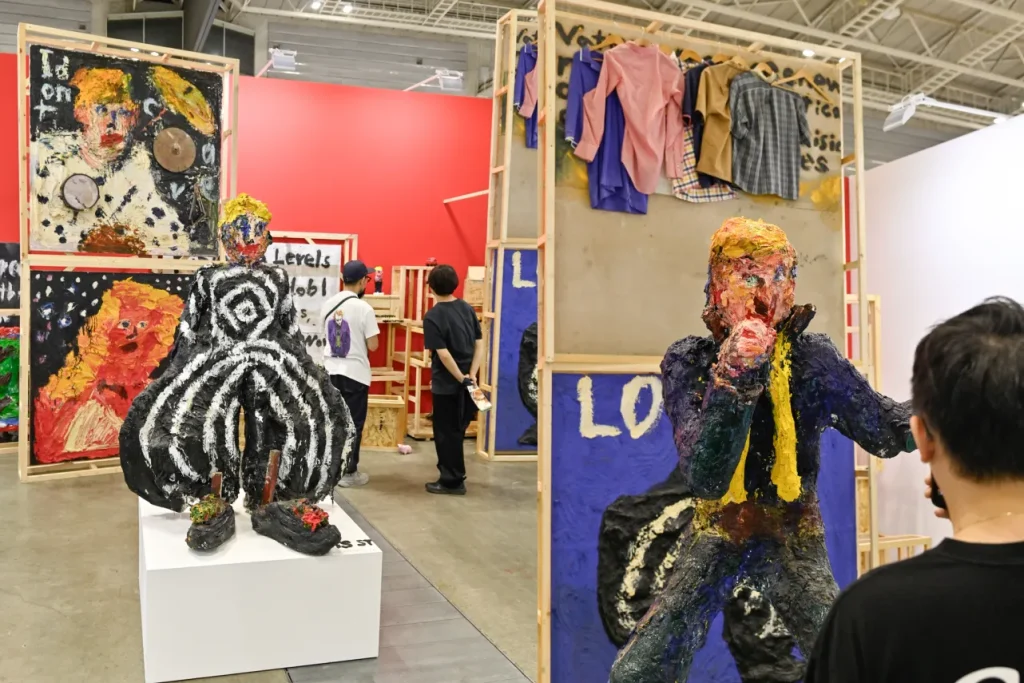
Nanae Mitobe − HARUKAITO by ISLAND
He's a sexy fighting star
Stars who have passed away are commonly revisited in the context of news and contemporary social issues with each changing era, and are reexamined. Then, common sense and established theories once considered absolute or universal are subject to change. Since the rise of the BLM movement, issues such as gender, race, and colonial history—the structures among minority people—have become important themes for Mitobe, who has consistently engaged in portraiture.
In the sculpture section of this exhibition, David Bowie is put center stage. These portraits of famous stars were not created through direct depiction of their faces, but rather through indirect representations based on how they appear in the media.
Consequently, the motifs are created as reproduction images, such as magazine covers or record jackets.
In the venue, records and musical instruments are scattered across the space—some even attached directly to the canvas—suggesting that a fight or conflict might have taken place. However, this is a non-violent form of resistance through music and art. While it may at times convey tragic circumstances, it ultimately stands as a positive message aligned with those who choose to resist.
Oil on plaster, 190 x 110 x 20 cm, 2024
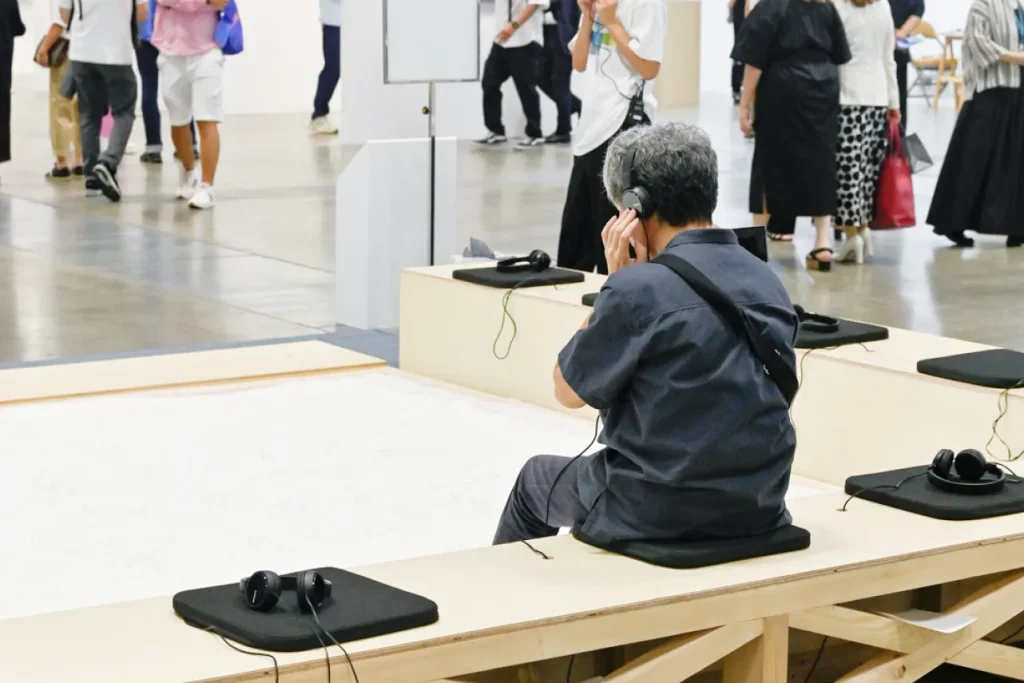
Nathalie Vairac − space Un
Inspire / Expire
Inspire / Expire is an immersive installation and performance where salt, memory and voice converge. Audiences sit at the edge of a vast salt pool, listening through headphones to a layered dialogue exploring collective memory, time, and transformation, guided by the artist’s personal journey.
This installation was developed during the artist’s first half of residency at space Un in Yoshino Nara (May 2025), serves as the foundation for the performances in Tokyo and a culminating premiere in Yoshino in early 2026. Each iteration deepens the conversation around memory, history, and transformation.
Installation, 250 x 250 x 300 cm, 2025
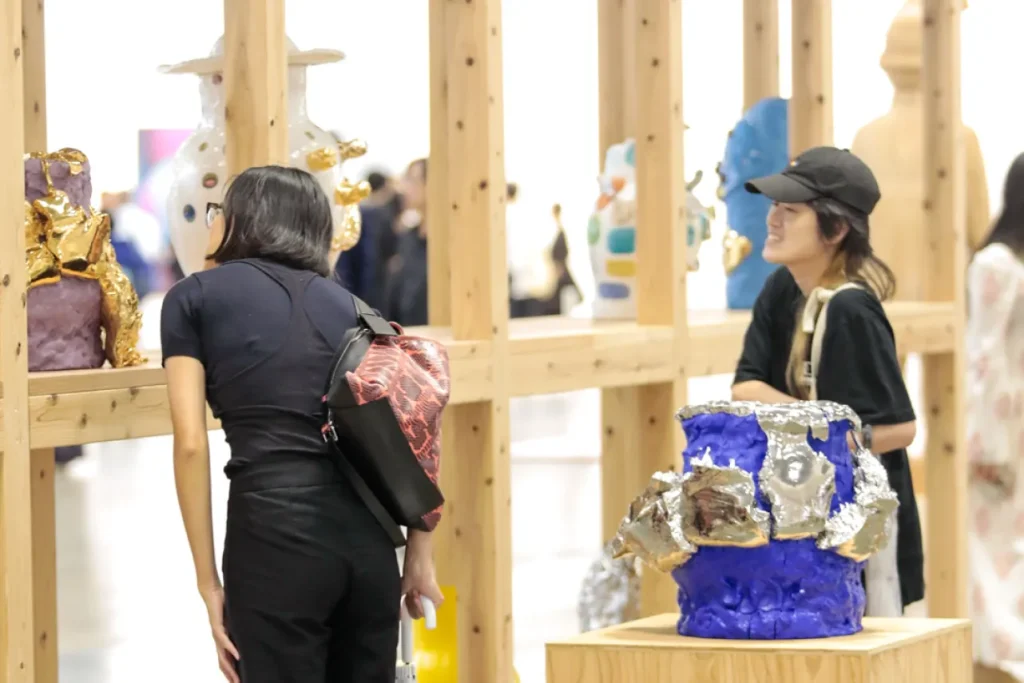
Takuro Kuwata & Dan McCarthy − KOSAKU KANECHIKA
Dear Friend
KOSAKU KANECHIKA exhibited a dual presentation with Takuro Kuwata and Dan McCarthy in Sato ‘Meadow’ at the 2025 edition of Tokyo Gendai. The project, titled “Dear Friend”, spotlights an intimate dialogue between two artists working in ceramics that articulates their distinct yet connected approaches to the medium, straddling the abstract and figurative, and contextual differences in the US and Japan. On display was a variety of sculptures demonstrating instinctual, playful, and dynamic encounters with clay.
Kuwata creates contemporary sculptures that continue a legacy of ceramic making that is rooted in tea ceremony. His tea bowls and sculptures arise out of and pays respects to an ancient tradition, yet his contemporary sensibility and penchant for breaking boundaries manifest in his vivid, metallic colors and unconventional form.
Influenced by his upbringing in California, McCarthy’s intentionally uncomplicated, modest, and direct ceramics emphasize touch and tactility. The foundation of McCarthy’s practice is to instinctively form wet, heavy clay into shapes with a “sense of immediacy and buoyant spirit.” Exemplified by his “Facepot” series, his work exudes a cheerful and impish quality upon first glance, yet also embodies a disconcerting emptiness that is hidden from plain view.
View the full list of artworks here.
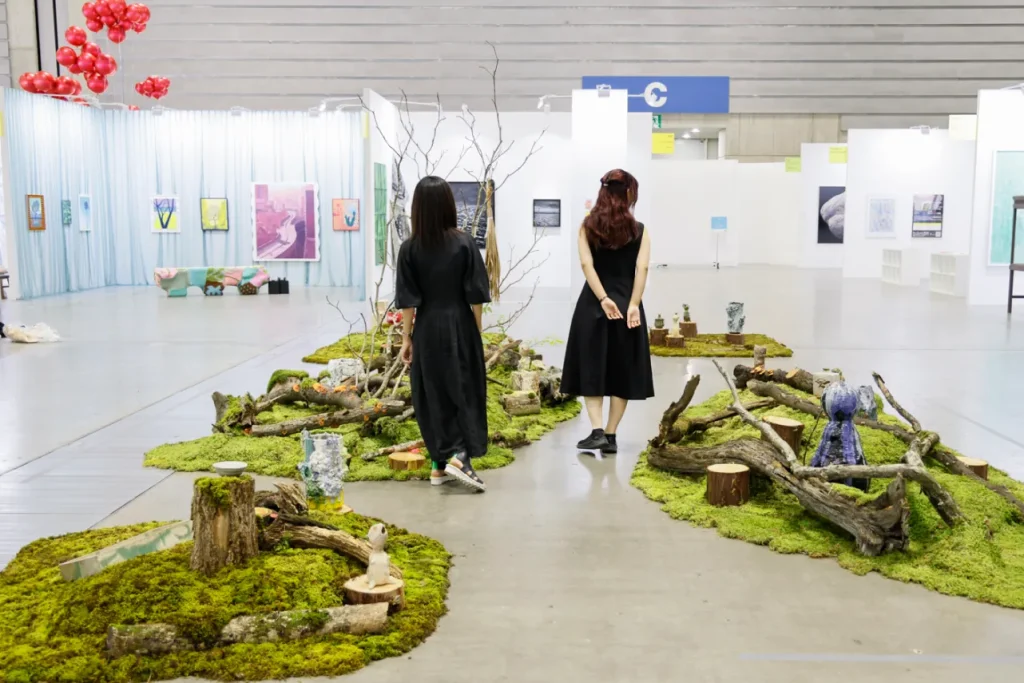
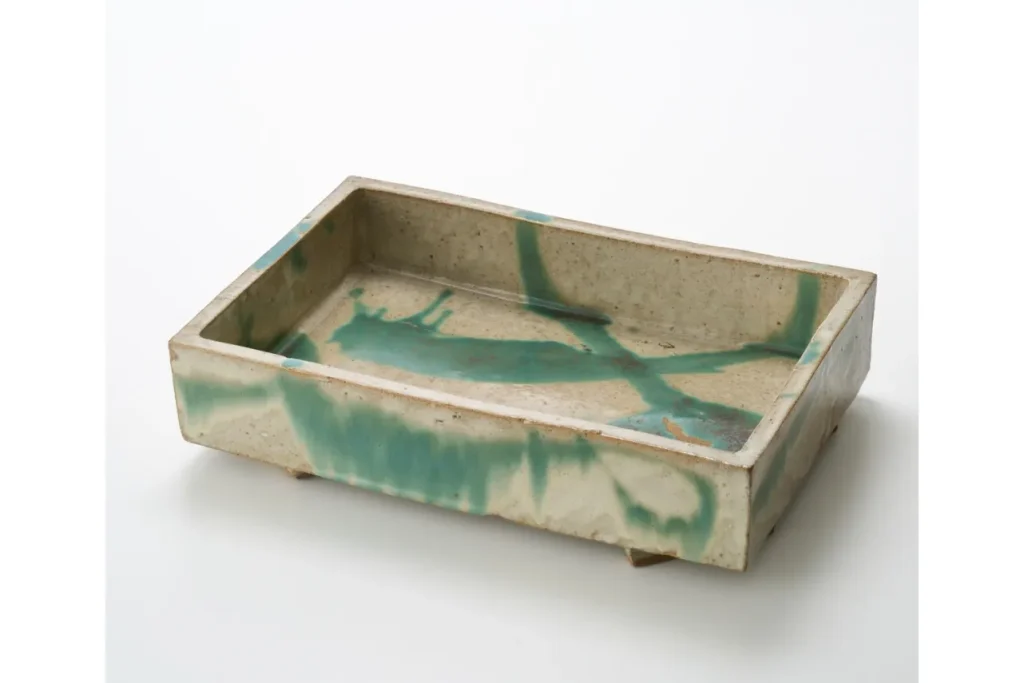
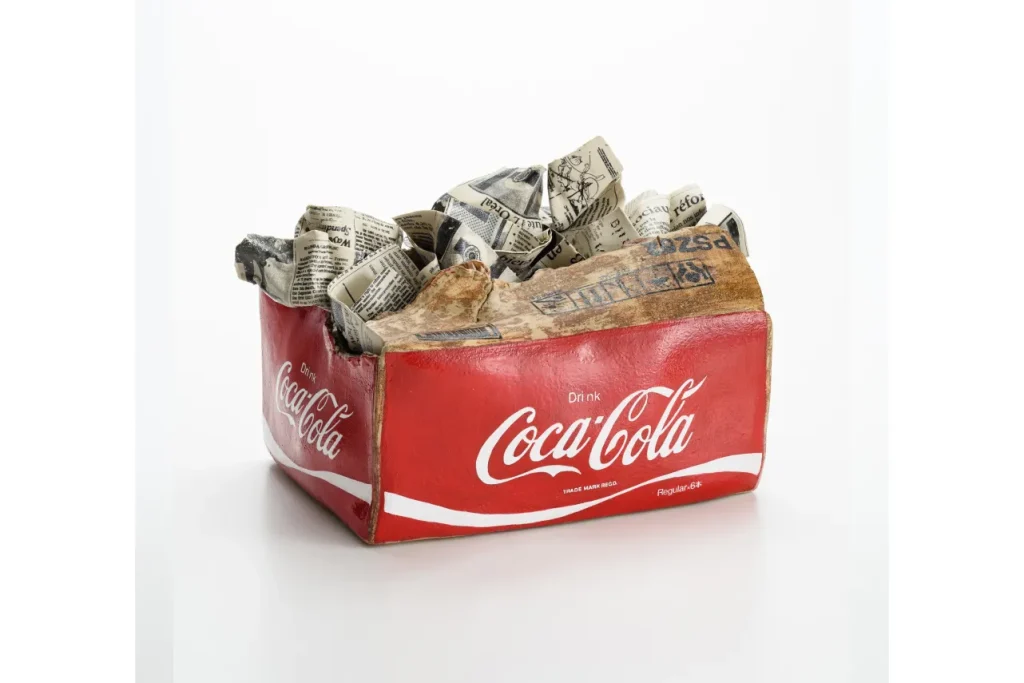
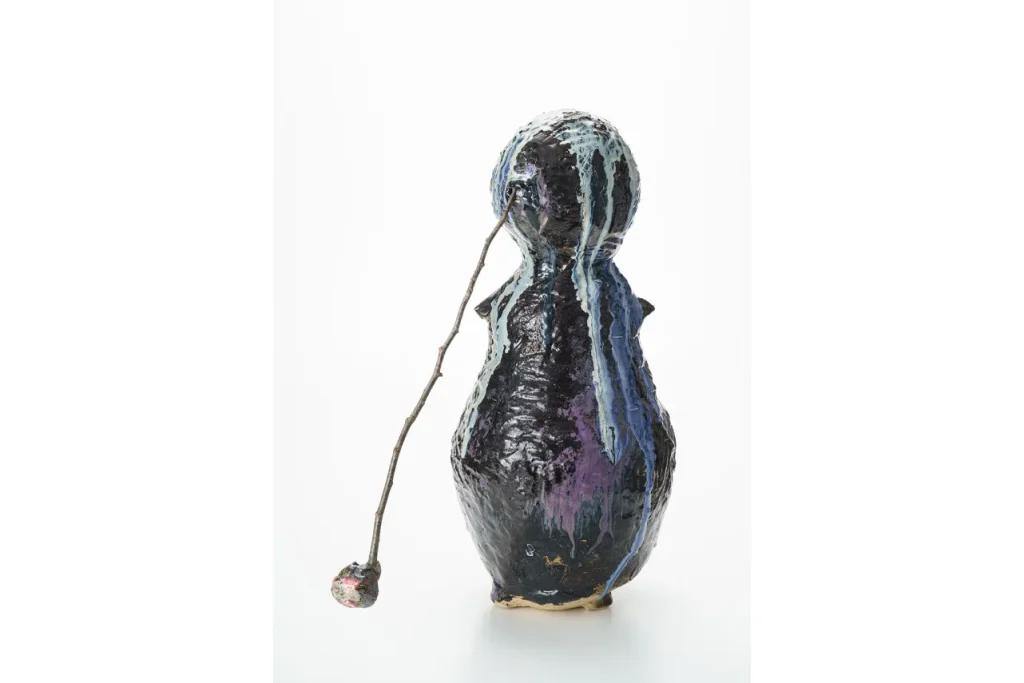
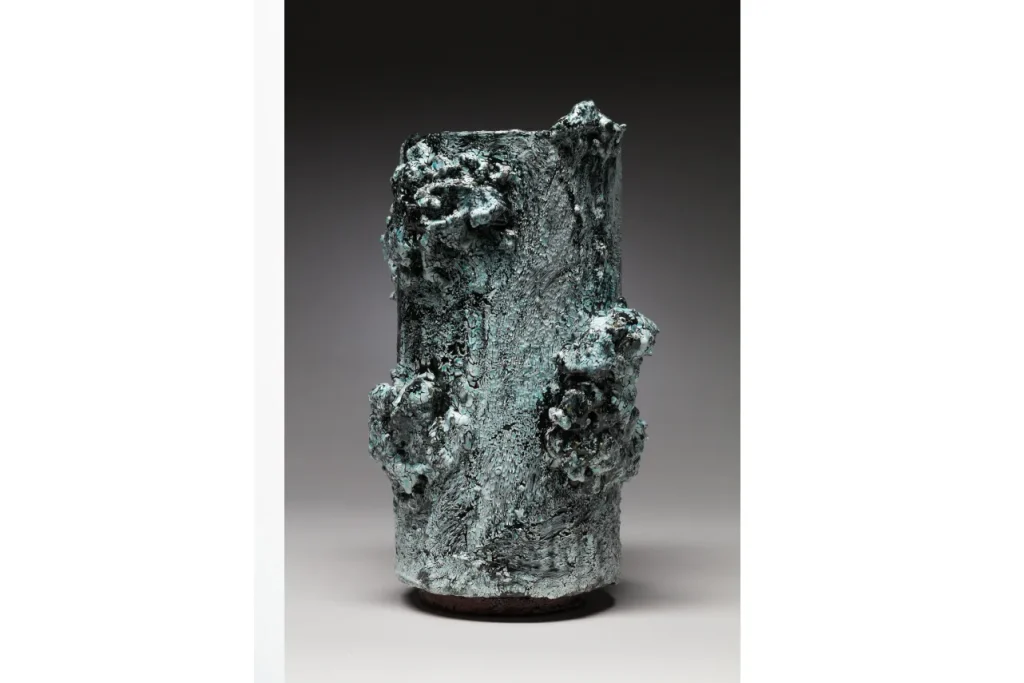
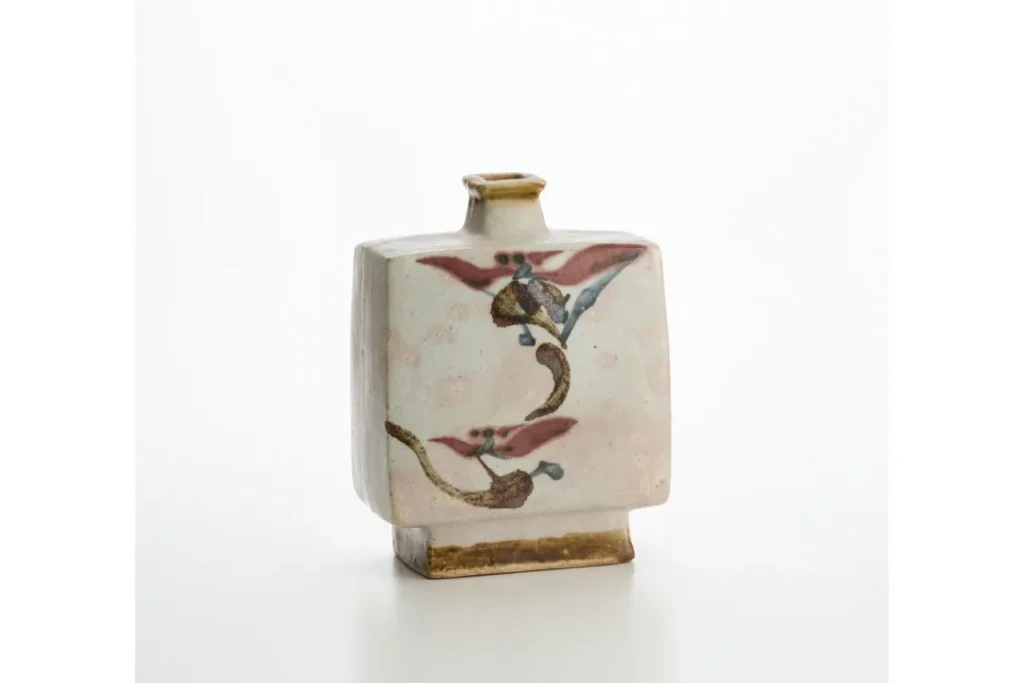
Bernard Leach, Edgar Sarin, Kawai Kanjiro, Kimiyo Mishima, Shoji Hamada, Sylvie Auvray, Tony Marsh
Art Fair for our Earth
In an era of rapid modernization in Japan, Kawai Kanjiro conveyed the importance of harmony with nature. Building on this philosophy, this exhibition features Kawai’s artworks, key figures in the Mingei (folk craft) movement ―Shoji Hamada and Bernard Leach―, as well as contemporary artists influenced by Mingei, and Kimiyo Mishima, known for her warnings on mass production with her positive humor. The works was presented within a forest-like installation incorporating moss and native plants from the Yokohama area, offering a new vision for environmentally conscious art fairs that minimize ecological impact.
Forest-planning supported by: PLANTED. Advisory: Nicolas Trembley.
See the full list of works here.
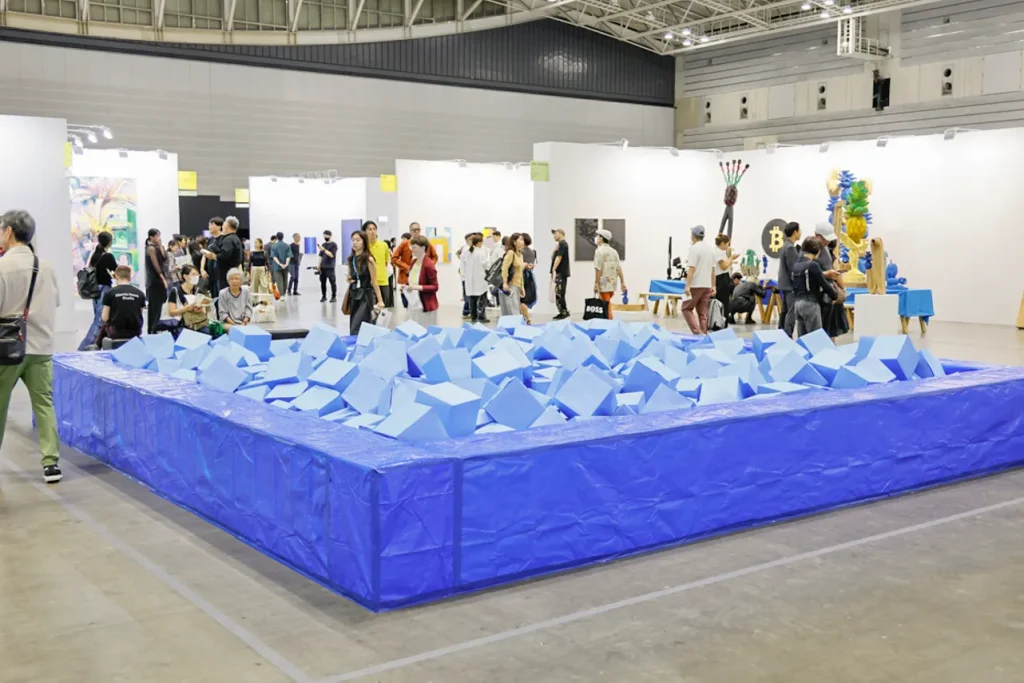
Douglas Watt − Unit 17
Pit
“Pit” is a new installation by Vancouver-based artist Douglas Watt made specifically for Tokyo Gendai’s Sato ‘Meadow’ program. The work consists of a rectangular pit filled with hundreds of blue cardboard boxes. Here, Watt extends his practice of recreating public spaces from his neighbourhood and the fixtures within them. For the first time, rather than taking on a miniature or life-size scale, Watt expands a scene from his local pool’s diving practice area into a temporary monument. The work references both the foam pit, an architectural sports typology found globally used to soften falls during gymnastics practice, as well as the ubiquitous packaging used for online shopping delivery.
Paper, cardboard, tarpaulin and tape, 2025
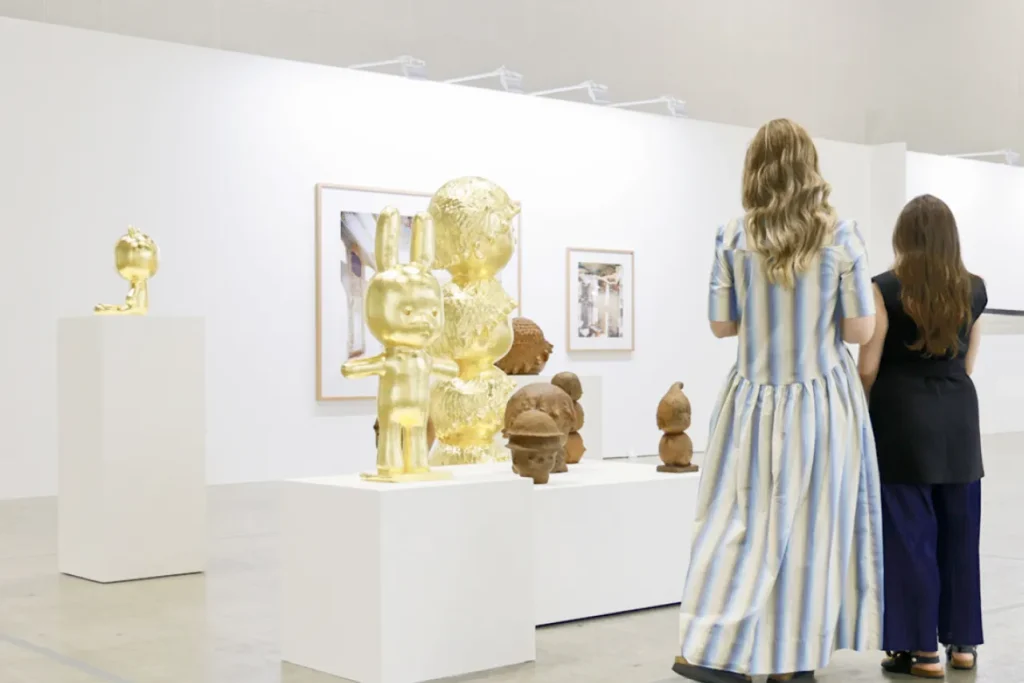
Otani Workshop − Kaikai Kiki Gallery
Sleeping Child Tower
Based in Awaji Island, Otani Workshop explores a wide range of expressions grounded in ceramics, extending to bronze, FRP, and painting. This presentation featured an installation of sculptural works centered around the 170 cm tall bronze piece “Sleeping Child Tower”.
Gold leaf on bronze, 170 x 76.1 x 77.3 cm, 2022
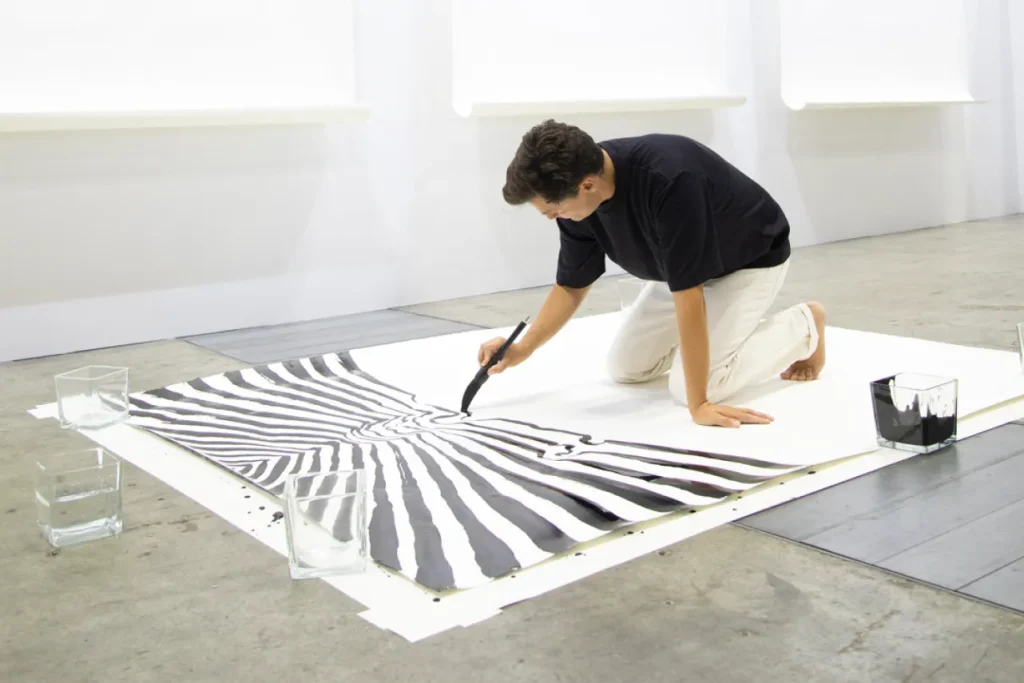
Carl Krull − Formation Gallery
Vertex
Created especially for Tokyo Gendai, Vertex is a new live drawing performance by Danish artist Carl Krull, in which he engages a large-scale sheet of paper using ink to create a dynamic topographical figure. Krull’s technique involves layering lines that resemble longitudes, latitudes, and meridian curves, forming intricate networks that challenge the inherent flatness of the medium. This method allows imperfections to evolve and multiply, generating organic forms that seem to emerge naturally from the paper’s surface.
Four large-scale ink drawings on paper were created over the course of the fair—one each day—allowing audiences to witness the unfolding process of a living artwork in real time.
In this performance, Krull draws deeply from Japanese calligraphy traditions—not only in his use of brush and ink but also in the meditative, disciplined execution of each line. The act of drawing becomes a performative ritual: every stroke is deliberate and imbued with intention, echoing the principles of shodō (Japanese calligraphy).
By integrating these elements, Vertex transcends conventional notions of drawing, transforming into a sculptural experience that bridges Western and Eastern artistic practices. The performance celebrates the universality of the line as a fundamental and expressive force.
Carl Krull performed on-site at Tokyo Gendai in booth #S11 during the following dates and times.
11 September 6:30 PM – 7:30 PM
12 September 12 PM – 1 PM
13 September 1 PM – 2 PM
14 September 12 PM – 1 PM
Performance/ink on paper
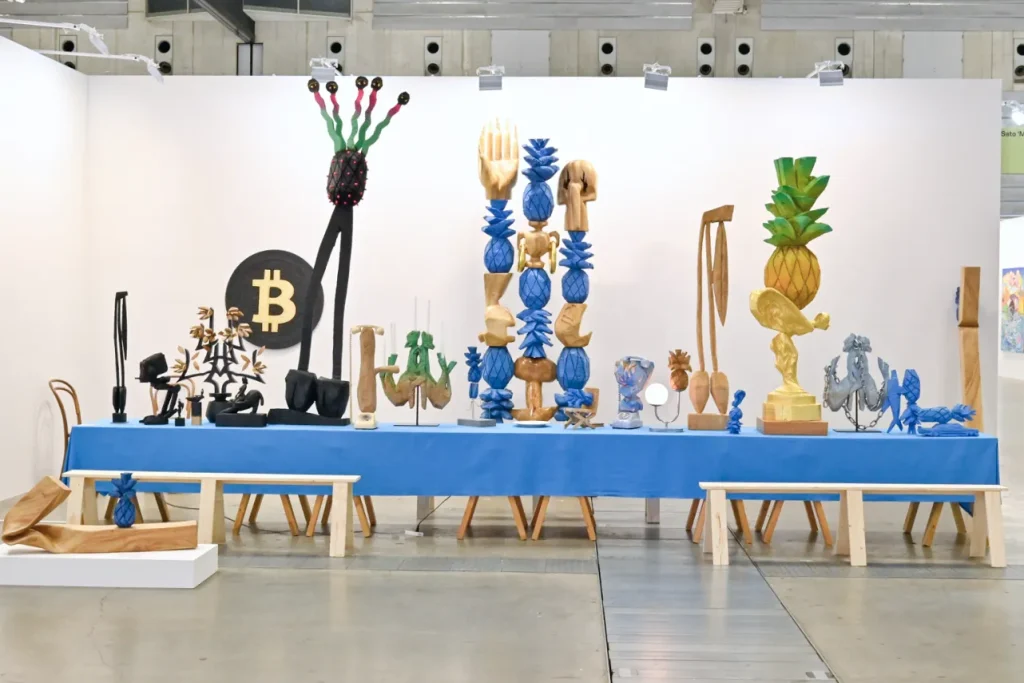
Ryuichi Ohira − NANZUKA
The Last Supper
Ryuichi Ohira’s installation The Last Supper gathered works created between 2015 and 2025, arranged on a single blue table.
Sculptures and objects born from different times, purposes, and concepts came together for the first time, forming a confluence of unexpected connections. The installation included rarely seen earlier works alongside more recent pieces, inviting viewers to share in a symbolic banquet of the artist’s decade-long creative trajectory. Rather than illustrating a single concept, the work emphasized the contingency of artistic production and the way meaning emerges through relationships among things. The Last Supper became a collective space in which audiences are invited to experience Ohira’s evolving practice as an open dialogue of chance and encounter.
Mixed media installation, 300 x 600 x 300 cm, 2015-2025
Mixed media installation, 300 x 600 x 300 cm, 2015-2025

